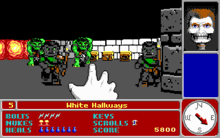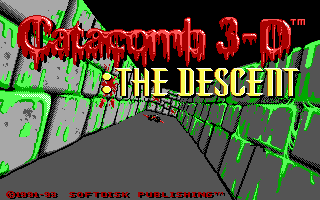Catacomb 3-D
| Catacomb 3-D | |
|---|---|
|
Title screen | |
| Developer(s) | id Software |
| Publisher(s) | Softdisk |
| Director(s) | Tom Hall |
| Designer(s) | John Carmack |
| Composer(s) | Robert Prince |
| Engine | Prototype of Wolfenstein 3D engine |
| Platform(s) | DOS, Amiga, Amiga CD32 |
| Release date(s) |
‹See Tfd›
|
| Genre(s) | First-person shooter |
| Mode(s) | Single-player |
Catacomb 3-D (also known as Catacomb 3-D: A New Dimension, Catacomb 3-D: The Descent, and Catacombs 3) is the third in the Catacomb series of video games (created by the founders of id Software), and the first of these games to feature 3D computer graphics. The game was originally published by Softdisk under the Gamer's Edge label, and is a first-person shooter with a dark fantasy setting. The player takes control of the high wizard Petton Everhail, descending into the catacomb of the Towne Cemetery to defeat the evil lich Nemesis and rescue his friend Grelminar.
Catacomb 3-D is a landmark title in terms of first-person graphics. The game was released in November 1991 and is arguably the first example of the modern, character-based first-person shooter genre, or at least it was a direct ancestor to the games that popularized the genre. It was released for DOS with EGA graphics. The game introduced the concept of showing the player's hand in the three-dimensional viewpoint, and an enhanced version of its technology was later used for the more successful and well-known Wolfenstein 3D. The game's more primitive technological predecessor was Hovertank 3D.
Production
The origins of the games are Catacomb by John Carmack for the PC and Apple II. This is a two-dimensional game utilizing a third-person view from above, released in 1989-1990. It was followed up with Catacomb II, which used the same game engine with new levels. The first release of Catacomb 3-D was called Catacomb 3-D: A New Dimension, but it was later re-released as Catacomb 3-D: The Descent, as well as Catacombs 3 for a re-release as commercially packaged software (the earlier versions had been released by other means such as disk magazines and downloads).[1] The game creators were John Carmack, John Romero, Jason Blochowiak (programmers), Tom Hall (creative director), Adrian Carmack (artist), and Robert Prince (musician).

id Software's use of texture mapping in Catacomb 3-D was influenced by Ultima Underworld (still in development at Catacomb 3-D's release). Conflicting accounts exist regarding the extent of this influence, however. In the book Masters of Doom, author David Kushner asserts that the concept was discussed only briefly during a 1991 telephone conversation between Underworld developer Paul Neurath and John Romero.[2] However, Paul Neurath has stated multiple times that John Carmack and John Romero had seen the game's 1990 CES demo, and recalled a comment from Carmack that he could write a faster texture mapper.[3][4]
Catacomb Adventure Series
Catacomb 3-D was followed by three games, in the so-called Catacomb Adventure Series. They were not developed by id Software but internally by Softdisk with a new staff for Gamer's Edge, who also made the later Dangerous Dave sequels. All of the games, including the original Catacomb titles, are now distributed legally by Flat Rock Software through their own web store and via GoG.com. Flat Rock have also released the source code for the games under the GNU General Public License in June 2014 in a manner similar those done by id and partners.[5]
The credits for the series are Mike Maynard, James Row, Nolan Martin (programming), Steven Maines (art direction), Carol Ludden, Jerry Jones, Adrian Carmack (art production), James Weiler, Judi Mangham (quality assurance), and id Software (3D imaging effects). The series' development head, Greg Malone, later became creative director for Duke Nukem 3D and also worked on Shadow Warrior for 3D Realms.[6] Department heads Mike Maynard and Jim Row, meanwhile, would co-found JAM Productions (soon joined by Jerry Jones), the creators of Blake Stone using an enhanced Wolfenstein 3D engine.[7]
Catacomb Abyss
Catacomb Abyss was the sequel to Catacomb 3-D, and featured the same main character in a new adventure: since his defeat, some of Nemesis' minions have built a mausoleum in his honour. Fearful of the dark mage's return, the townspeople hire Everhail to descend below and end the evil. The environments are more varied than in Catacomb 3D, featuring crypts, gardens, mines, aqueducts, volcanic regions and various other locales. It was the only game in the series that was released as shareware, released by Softdisk in 1992.
Catacomb Armageddon

Catacomb Armageddon is the sequel to Catacomb Abyss, only now set in the present day. The levels featured, among others, towns, forests, temples, torture chambers, an ant colony, and a crystal maze. It was developed by Softdisk and was later republished by Froggman under the title Curse of the Catacombs.
Catacomb Apocalypse
Catacomb Apocalypse is the final game in the Catacomb Adventure Series. It was set in the distant future, accessible via time portals, and mixed fantasy and science fiction elements, pitting players against robotic necromancers and the like. It is also the only game in the trilogy to have a hub system, though it was present in the original Catacomb 3D. It was developed by Softdisk and later republished by Froggman under the title Terror of the Catacombs.
Reception
Computer Gaming World called The Catacomb Abyss "very enjoyable" despite the "minimal" EGA graphics and sound.[8]
References
- ↑ History - Catacomb Crypt
- ↑ Kushner, David (2003). Masters of Doom: How Two Guys Created An Empire And Transformed Pop Culture. Random House. 89. ISBN 0-375-50524-5.
- ↑ Mallinson, Paul (16 April 2002). "Feature: Games that changed the world: Ultima Underworld". Computer and Video Games. Retrieved 10 February 2009.
- ↑ James Au, Wagner (5 May 2003). "Masters of "Doom"". Salon.com. Retrieved 9 March 2009.
- ↑ Larabel, Michael (6 June 2014). "id Software's Softdisk Open-Sources Some Really Old Games". Phoronix. Retrieved 6 June 2014.
- ↑ The Apogee FAQ – What's Apogee's relationship with Softdisk?
- ↑ The Apogee Legacy 12# – Mike Maynard, 3D Realms News, 27 March 2006
- ↑ Miller, Chuck (May 1993). "Dungeons Make Me Dizzy". Computer Gaming World. p. 46. Retrieved 7 July 2014.
External links
- id's look back at Catacomb 3D
- Source code on gitHub
- Catacomb 3-D at MobyGames
- Catacomb series at MobyGames
- Catacomb series at DMOZ
- Amiga release 2016
